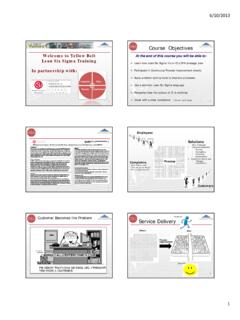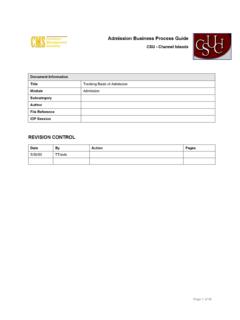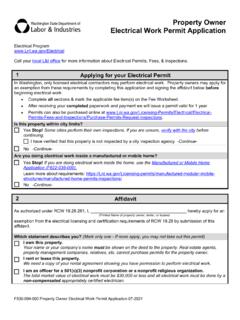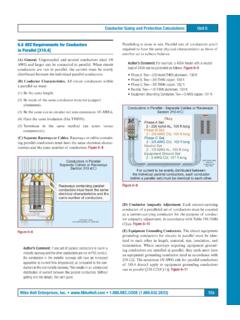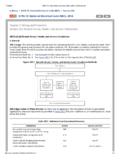Transcription of Energized Electrical Work Safety Procedures
1 WRK Rev. 10/13/2010 ENVIRONMENT, Safety , RISK MANAGEMENT 1 Energized Electrical Work Safety Procedures Purpose The safest way to conduct Electrical work is to shut off electric power and work on de- Energized equipment. At CSUCI our intent and standard practice will be to avoid Energized Electrical work. In virtually all cases it should be possible to shut off power and utilize proper lock out Procedures , thus conducting work in the safest manner possible. However, there may arise extraordinary circumstances that necessitate work on Energized equipment, for example when shut down would create a significant Safety or health hazard or when work must be conducted near, but not on, live equipment.
2 Diagnostic Procedures also often require Energized Electrical work. The following general approach will be used when conducting Energized Electrical work. Only authorized workers will be allowed to perform Electrical work. For a worker to be authorized training will be required. Prohibition of work: in recognition of the fact that we can anticipate more likely hazard or failure when working on certain older or less well characterized equipment, we may prohibit live work in certain situations. There are two basic hazards when performing live work, electric shock and Electrical explosion (arc flash). Arc flash can cause burns and explosive force trauma injury.
3 These hazards can be controlled using structured Safety Procedures and appropriate Personal Protective Equipment (PPE). This document describes the administrative Procedures and PPE required for conducting Energized Electrical work safely. Responsibilities The following persons / entities have responsibilities as delineated below for implementation of this procedure: Environment, Safety Risk Management Office It is the responsibility of Environment, Safety Risk Management to: a) Maintain and update this Procedure as necessary. b) Provide consultation regarding program compliance. The office can provide consultation on such issues as: hazard identification and evaluation; Procedures for correcting unsafe conditions; systems for communicating with employees; employee training programs; compliance strategies; and record keeping.
4 WRK Rev. 10/13/2010 ENVIRONMENT, Safety , RISK MANAGEMENT 2 Deans, Directors, Program Chairs, Program Heads It is the responsibility of Deans, Directors, Program Chairs, and Program Heads to: a) Develop and maintain written departmental Procedures as necessary and ensure that each supervisor adheres to adopted Procedures . b) Develop and implement an education and training program designed to instruct employees in safe work practices related to preventing injuries and illnesses from Electrical hazards. c) Provide necessary Safety equipment, including personal protective equipment designed to prevent Electrical and arc flash injuries, to employees, at no cost to the employee.
5 Principal Investigators and Supervisors Ii is the responsibility of Principal Investigators and Supervisors to: a) Develop workplace Procedures to ensure effective compliance with this and other Safety Procedures . b) Ensure that each employee adheres to adopted Procedures . c) Instruct employees in the recognition and avoidance of unsafe conditions. Ensure that newly hired, newly assigned or reassigned employees are properly trained in all Safety Procedures associated with their new duties. Employees It is the responsibility of all employees, including student employees, to: a) Read and comply with Procedures and guidelines provided by their supervisors.
6 B) Inform their supervisors of workplace hazards without fear of reprisal. c) Attend established education and training sessions; understand and comply with all applicable Safety requirements. Failure to comply with established Safety rules may be reflected in performance evaluations and may lead to disciplinary action consistent with Procedures described in respective collective bargaining contracts, where applicable. d) Ask questions of their supervisors when there is concern about an unknown or potentially hazardous situation. Definitions Accessible (as applied to equipment). Admitting close approach; not guarded by locked doors, elevation, or other effective means.
7 Accessible (as applied to wiring methods). Capable of being removed or exposed without damaging the building structure or finish or not permanently closed in by the structure or finish of the building. WRK Rev. 10/13/2010 ENVIRONMENT, Safety , RISK MANAGEMENT 3 Accessible, Readily (Readily Accessible). Capable of being reached quickly for operation, renewal, or inspections without requiring those to whom ready access is requisite to climb over or remove obstacles or to resort to portable ladders, and so forth. Attachment Plug (Plug Cap) (Plug). A device that, by insertion in a receptacle, establishes a connection between the conductors of the attached flexible cord and the conductors connected permanently to the receptacle Branch circuit .
8 The circuit conductors between the final overcurrent device protecting the circuit and the outlet(s). Conductor, Bare. A conductor having no covering or Electrical insulation whatsoever. Conductor, Insulated. A conductor encased within material of composition and thickness that is recognized by the NEC as Electrical insulation. Deenergized. Free from any Electrical connection to a source of potential difference and from Electrical charge; not having a potential different from that of the earth. Disconnecting Means. A device, or group of devices, or other means by which the conductors of a circuit can be disconnected from their source of supply. Electrical Single-Line Diagram.
9 A diagram that shows, by means of single lines and graphic symbols, the course of an electric circuit or system of circuits and the component devices or parts used in the circuit or system. Electrically Safe Work Condition. A state in which the conductor or circuit part to be worked on or near has been disconnected from Energized parts, locked/tagged in accordance with established standards, tested to ensure the absence of voltage, and grounded if determined necessary. Enclosed. Surrounded by a case, housing, fence, or wall(s) that prevents persons from accidentally contacting Energized parts. Enclosure. The case or housing of apparatus, or the fence or walls surrounding an installation to prevent personnel from accidentally contacting Energized parts, or to protect the equipment from physical damage.
10 Energized . Electrically connected to or having a source of voltage. Exposed (as applied to live parts). Capable of being inadvertently touched or approached nearer than a safe distance by a person. It is applied to parts that are not suitably guarded, isolated, or insulated. Exposed (as applied to wiring methods). On or attached to the surface or behind panels designed to allow access feeder . All circuit conductors between the service equipment, the source of a separately derived system, or other power supply source and the final branch- circuit overcurrent device. Guarded. Covered, shielded, fenced, enclosed, or otherwise protected by means of suitable covers, casings, barriers, rails, screens, mats, or platforms to remove the likelihood of approach or contact by persons or objects to a point of danger.
